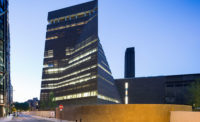Herzog & de Meuron's Tate Modern Expansion Approved

Tate Modern Gallery.
Image © Herzog & de Meuron

Tate Modern Gallery.
Image © Herzog & de Mueron

Tate Modern Gallery.
Image © Herzog & de Meuron

Tate Modern Gallery
Image © Herzog & de Meuron




The Swiss architectural duo’s plans for an 11-story, pyramidal tower of stacked, glazed boxes will increase the Tate Modern’s size by 60 percent. This is their second time working on the building, a converted 1930s-era power station. In 2000, Herzog & de Meuron revamped the 252,000-square-foot structure to accommodate an anticipated 1.8 million visitors annually. But the gallery quickly proved a runaway success—the first year alone saw 5 million visitors, a figure that has since settled into a steady 4 million people—necessitating more space.
The $324 million addition will equip Tate Modern with more galleries for showing contemporary visual culture, as well as more education rooms and catering facilities; a new 10th floor restaurant and roof terrace will offer panoramic views of London. Herzog & de Meuron has also designed a new park and pedestrian routes around the entire complex. A north-south “street” running between the old and new buildings will form the centerpiece of this plan, helping to draw visitor traffic into the surrounding neighborhood of Southwark, a former industrial zone now being transformed.
Tate Modern’s commitment to fine architecture and the regeneration of London will also be underlined by new exhibitions. For the first time ever, the museum will offer regular architecture shows every two years. Global Cities, opening in June, will focus on topical urban issues in London and nine other cities worldwide and examine the effects of globalization. Adapted from the centerpiece exhibit created for the Venice Architecture Biennale in 2006, it draws on research from the London School of Economics to explore the themes of speed, size, density, diversity, and form. Architects Zaha Hadid, Rem Koolhaas, Herzog & de Meuron, and artists Richard Wentworth and Nils Norman, are among the exhibitors in the show.









